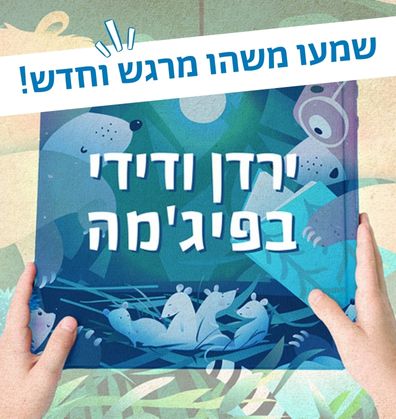אֲנִי וְעַצְמִי
סבלנות
"סבלנות – לא קונים בשום חנות!" מדקלמות גננות ומדקלמים הורים במשך שנים, בניסיון להנחיל מיומנויות התנהגות של המתנה ושל דחיית סיפוקים. כמה שזה קשה! ספרים שעוסקים בקושי לחכות, להתאפק ולהמתין כשצריך, יכולים לסייע בשכלול המיומנות והיכולות להתאזר בסבלנות.
סְּפָרִים
Book-Related Family Activities
Discussion – How can we cheer ourselves up?
“Even in rough times – Shmulek can count on his harmonica” –What helps you during hard times? You can discuss and share ideas on how to cheer yourself up when you are sad or times are hard: It can be a tune, a dream, or a hug from someone you love.
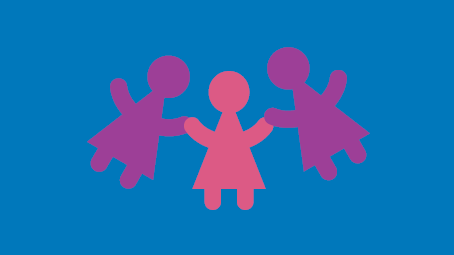
Heartbeats of memories
Which songs are your favorite? You can listen to songs you like when you are sad or happy, in the morning , or those that help you fall asleep. You may want to create a family soundtrack of favorite songs to listen to when the mood is right.

A dream box
Shmulek places his teeth that had fallen out in a box. You can also find a box, decorate it, and place special objects in it, such as treasures that you have found, or paintings of dreams that you would like to make come true.
A discussion on yearning
How does yearning feel? Have you ever missed someone? Who? – This book is an opportunity for a discussion during which you, parents, can share your own experiences of missing someone and waiting for their return.
What does it mean to miss someone?
Pupik misses his father, and Ohad knows exactly how he feels. They share their feelings, and think of things they could do while missing someone. You may want to scan this QR code to watch them, and get some good advice for times when you miss others.
Arts & crafts – A yearning box
Does it feel like time is standing still while you are missing someone who is away? – You may want to make a box filled with items that could make time go by faster, and make you forget about that person’s absence for a while. How about putting some photos of the two of you in it, materials with which to make a gift or a drawing for them, which you could give to them upon their return?
A game for passing the time
A minute can go by very quickly, or it can almost stand still. Would you like to try? – Set your timer for one minute, choose an activity, and do it for a full minute: Hopping on one leg, sitting still, finding items beginning with the letter G – Which activity helped time pass by faster? And which activity made it go by extra slowly?
Discussion
What do we do when we can’t decide which step to take? Who do you like getting advice from? Whose advice do you find difficult to follow, and why? Sometimes good advice comes unexpectedly: you may want to discuss that with your child, be reminded of times when you chose to listen to a piece of advice you’d been given, and share the things you’ve learned from others, young as well as old.
Enjoying the way
Are you traveling on a long, perhaps boring road? You could pass the time by playing games: counting the road signs along the way, recognizing familiar letters, discovering the changes to your surroundings brought on by the different seasons, singing your favorite songs and also… looking at the road and enjoying the existence of things you have not noticed until now.
Learning from everyone
What could children teach adults? And what could adults teach children? You may want to share your knowledge with one another, and try it out together: You could teach each other a game, song, or dance, share sports knowledge, information on a certain animal or anything else that comes to mind. Did you teach? Have you learned? Now swap roles.
A game – How do you get to…?
How do you get from one place to another by listening? Stand in the doorway with your eyes closed, and ask your family members to lead you safely to another room in the house by giving you instructions. You could follow up by playing a board game inspired by this book which we have created for you.

יש לכם קופסה? יש לכם משחק!
יש לכם קופסה? יש לכם משחק! צפו בסרטון וגלו איך להכין משחק קופסה מתוק מדברים שיש בכל בית, בעקבות הספר “המתנה” מאת אַנְיֵיס לָרוֹשׁ!

Reading & discussing
Once you have finished reading the book, you could discuss what Michael (originally: Nicodème) did: Why did he want to give his mother a present? What do family members give one another? And what would you like to get from yours? Would you like to receive material gifts, such as toys, or are there “gifts” of conduct, intimacy, and friendship that you would like to give and receive?

Looking at the illustrations
Some of the special illustrations in the book are black and white, while others are colorful. You may enjoy looking at them with your child and discovering: which illustrations did the illustrator choose to color? Why did he choose to color those items instead of others? Would you have chosen to color a different item?

Creative fun – What's in the box?
We readers do not know which gift is contained in the box that Michael (originally: Nicodème) gives his mother. Perhaps the book is trying to tell us that it’s the act of giving that matters most. However… wouldn’t you love to know what was in there? Well, how about making a giftbox by taking a box, decorating it, and covering it with giftwrap. You could use the box to play a game called “What’s rattling in the box?”: Collect some “rattling” items, and place one in the box at a time. Then let each of the participants shake the box, listen to the item rattle inside, and try to guess what it is.

The gift of waiting
Michael (originally: Nicodème) waited patiently for this day to come, but many children find the wait a difficult challenge. You may want to share some waiting experiences together at home: making pastries with yeast, baking cookies, etc. or playing waiting games like the staring game. How patient are you?
Proposed Family Activities:
- You may want to leaf through the book together. Did you find anything about the illustrations amusing? You may want to ask your child to use them in order to identify the different characters’ activities.
- At the end of the book, the entire family sits down for a Shabbat meal together. Can your child identify each character as it sits round the table? You may want to ask them to point at some of them, and try to remember the two activities each of them likes to do.
- You may enjoy holding a Shabbat meal for some toys using plastic dishes. You could ask your child who to invite, what the toys should have, what they can do while dining together, and what is best not to do while sitting around the table.
- You may want to try doing different things at the same time, like singing and playing ball, showering while listening to a story, or putting toys away while clapping. Were you able to do both?
- You could discuss your family with your child. Ask them when you usually get together for a meal, and what you usually do on Shabbat.
What pictures tell us:
Your child may want to look at the illustrations, and discover details that do not appear in the text. Were they able to find the cat and bird? What do the animals do on each page?
What do we wear in winter?
You could go to your closet, and look for winter clothes – flannel undershirts, gloves, socks, boots, and umbrellas. You may enjoy playing a game together in which one of you closes their eyes, names an item of clothing, and counts to ten, and the other must put on that item of clothing before the time is up. How well did each of you do?
Young weather forecasters
Children can follow the weather from a young age. Before leaving the house, you may want to ask them to look up at the sky, and report – is it sunny or cloudy? Should we wear a coat, or take an umbrella?
Getting our toys dressed for winter
Does your child’s teddy-bear or doll have a coat, hat, or scarf? You may want to look for pieces of fabric, or used baby clothes, and help your toys prepare for a rain-filled winter too.
Drawing winter on the windows
On cold and rainy days, you could draw on the cold vapor that covers your windows. Perhaps you would like to draw clouds, and ask your child to mark the raindrops with their fingertips. You could add a puddle, or even an umbrella. You may want to return to the window an hour later – what happened to the drawing?
Games for rainy days
You may want to take a shoebox and fill it with various small surprises, such as stickers, special crayons, small containers of soap bubble liquid, and so on. Hide the box, and only open it on rainy days!
Do you like the rain and cold?
You can take a walk outside on wintry days too! You may want to look up at the clouds, and discover what they look like. Can you see a person’s face, or an animal? Perhaps you’ll get lucky, and have raindrops fall on your head. You could also talk as you walk, and tell each other what you like most about winter, and what you do not. What does the air smell like? What do the trees look like? Perhaps you would enjoy picking up dry leaves, jumping into puddles, and feeling the wind blow.
Family Activities
- Duvshan and Mummy do all kinds of things together. You can go over the illustrations in the book with your children and with their help, tell the story in your own words. Invite your children to “read aloud” the story from the point of view of little Duvshan, and you can tell the same story from the perspective of Mummy Bear. At the end, you may ask your children to choose one joint activity that is described in the book, and do it (or a similar activity) together.
- Honoring one’s parents: The story presents a wonderful opportunity to share your own experience with your parents, by recalling ways in which you honor or honored your parents. Be sure to let your children know how they honor you too!
- Duvshan helps Mummy with gardening work and in the kitchen. Your children can also honor you and help out around the house. They can help set the table, match socks from the laundry, or help dust the furniture. For very young children this is a wonderful opportunity to feel needed and learn that they are capable of helping out with household chores.
- Like Duvshan, many children like to prepare little “surprises” for their parents and show their independence. They can get dressed by themselves, wash themselves, pick up and organize their toys. And just like Duvshan’s Mummy, you too can marvel at your children’s desire to help you – and in return prepare a small surprise for them!
- A “patience clock”: We all know how difficult it can be for young children to be patient. Setting an alarm clock or an hourglass can help your child know when the “being patient” time has ended. If you plan what you’ll do together when the time is over, it might help the time pass even quicker.
- Many young children have a hard time thinking up ways of being on their own. For such instances you might want to prepare an “I Can Do It All By Myself” album together with your children, including a collection of drawings that describe ideas for independent activities. Each page can contain a different activity. Your child can color the pictures and you can add short sentences such as “I can draw”, “I can cut”, “I can water plants”, etc. Looking through the album will help the children choose an activity to carry out on their own while they’re waiting for you, and afterwards, just like Mummy Bear, you can say: “Oh, my little one, you are so talented!”
Family Activities
- Notice the fly in the illustrations that accompany the story: It, too, tries to irritate, and usually, it succeeds. Try to tell the story with your children from the fly’s vantage point.
- In order to shake Hillel out of his tranquility the man chose to approach him at a very inconvenient time of day: just before the start of the Sabbath. Are there times when it is not advisable to ask your children questions or to request something of them? Do your children know when it is not advisable to ask you questions?
- You can act out the story with your children. You can wrap the head of “Hillel” with a large towel, and add a tub and bath accessories. The “friend” can look for Hillel, call out to him and make up strange questions of his own. You are invited to photograph your skit and send the pictures to the Sifriyat Pijama website: pj.crunchcart.com/.
- In the story a man approaches Hillel and attempts to provoke him. Coping with provocation is a task required of almost all young children. The story about Hillel may present an opportunity for family discussion on the topic of teasing and provocation, and an invitation for your children to describe how they know when one child is trying to provoke another, and what one can do when this happens.
- You can make your own bubble bath: Take some old soap and shred it with a grater into a bowl. Add warm water and whip it with a mixer until you get thick suds. You can add a few drops of food coloring to the suds. The children will enjoy bathing with the special suds they made with you!
- Hillel was an exemplary figure who knew how to control his anger. What helps us overcome our anger? You can prepare a “Hillel doll” with your children. The children can ask for advice from the doll and tell it what helps them get over their anger. Make the doll from an old sock, on which you can draw a mouth, glue two eyes, and add white hair from cotton wool. You can even make a hat for the doll. Place your hand inside the sock, and have the doll answer the children’s or parents’ questions and make up new stories. This is also an opportunity for you to share with your children ways that help you cope with anger when it arises.
Family Activities:
- Do the members of your family enjoy it when it rains? After reading the story, you might have a conversation with your children and ask them whether they, like Tzafrir, love rain. Why? Who needs rain, and who enjoys it? Ask your children whether they know any other stories, songs, and tales about the rain. You can all snuggle together in a cozy corner of your home and tell stories about the rain.
- Tzafrir asks: “Mommy! Will the rain ever come?” Like many children, Tzafrir is full of anticipation and has a hard time waiting for the rainy season to begin. Suggest to your children that they look for changes in the weather that indicate winter’s coming (for example: birds migrating south, days getting shorter, skies becoming cloudy). You could also have a conversation about things in life that we can control, versus things over which we have no control.
- “Tzafrir was still a little boy last winter”: You might talk about things your children are able to do now that they couldn’t do last winter. You could also take out their shoes, clothes, and boots from last winter and see if they still fit, so your children can see how much they’ve grown and developed since then.
- Your children can join in anticipating and tracking the rain (or snow, if you live in a cold climate). Work together on designing a tracking chart. Every evening during the winter months, they can make a mark (or draw a picture) to indicate whether rain (or snow) fell that day. When the season is over, you can all count together the number of days on which there was some precipitation.
- You can also make a rain collector: take a plastic bottle and cut off the top (be careful not to cut yourselves on any sharp edges!). Place the empty bottle in an open area outdoors, or attach a loop of metal wire and hang it outside your window. How long does the bottle take to fill up? Your children can track the rise of the water level in the bottle, and then decide how they want to use the water they’ve collected.
- You and your children can also go on a puddle expedition, just like Tzafrir and his family. Don’t forget to wear boots and bring an umbrella!
- You can set aside special games and other entertainment, to be opened on rainy days! Ask your children to decorate an empty shoe box. You can then fill the box with small surprises, like stickers, paints, beads, or a bottle of soap bubbles, along with little handdrawn notes containing ideas for fun family activities for a rainy day (play word games; read books; cook and bake; etc.). Hide the box, and bring it out only when it rains!
Family Activities
- You may want to look through the book and enjoy the lovely illustrations. Can you spot the apple on every page? Some of the objects and animals remain constant, while others change position. Which are constant? Which are in motion?
- Have you noticed that the mouse is smiling almost throughout the book? How do you think it feels while waiting patiently?
- You may want to take puppets or stuffed animals to represent the characters in the story, and act it out to your family and friends.
- We all lose our patience at times, waiting on line at the cashier, or getting stuck in traffic. You may like to share an experience with your child in which you finally made it after having waited for something for a long time. What ‘gift’ did you get at the end of the long wait?
- Many children find it hard to wait for their parent to finish what they are doing, or for their turn to be on the computer. Perhaps you could mark the time left to wait on an analog clock. Children are often more patient when they know when their “patience time” will be over.
How about putting on your aprons and making apple confit?
Ingredients:
1 kg of green apples
1/2 kg of sugar
1 cinnamon stick
1 lemon
Peel the apples with a peeler, take out the cores and dice them. Cook the apples, sugar and cinnamon stick in a pot on a small burner for one hour (you must be patient!). Once cooked, add some squeezed lemon to your confit.
Be-teavon! Bon Appetit!
Every loaf starts with a single grain
“Every loaf starts with a single grain”: You may want to ask your child how “bread is brought out of the ground”, which forces of nature helped the wheat and other ingredients grow, and what one needs in order to turn wheat into bread.
ask your child to think of five things they like to eat
You could ask your child to think of five things they like to eat. Do they know what they are made of, and how they are prepared? You may want to make a “true meal” together, one that you make on your own from start to finish, including serving and clearing the table. Did you also feel satisfied with your effort and the entire process?
The princess did not want to disappoint her father
The princess did not want to disappoint her father, but hoped she could please him without making much of an effort. She ultimately overcame the difficulties she had encountered, and completed the task well. You may want to discuss the following with your child: Why do you think the king was unhappy with the ready-made loaves of bread brought to him by the princess? What is so special about the “true” loaf of bread? Have you ever been in a situation where you achieved something that was important to you after working hard, making a tremendous effort, or repeated attempts? You may want to share this experience and subsequent feelings with your child.
King Baguette looked at his princess'
King Baguette looked at his princess’ hands to determine whether she had brought him the true loaf of bread. You could also look at your child’s hands, and try to guess what they had done today. Children’s hands resemble their parents’, but are also different. You may want to compare your hands, and notice the lines “drawn” on them. Do you have the same lines?
At the end of the story
At the end of the story, the princess learned to appreciate the farmers’ hard work, and their contribution to her life, and even learned to thank them. Together with your child, you could think of the people around you who work hard to make everyone’s lives easier. You may want to try and count all the people who have helped us throughout the day (such as the people who clean the streets, security officers, bus drivers, those in building maintenance, etc.).
playing the "thank you game
You might enjoy playing the “thank you game”. A family member starts by saying “I’d like to thank…” and tells of a good thing another has done for them. It could be anything, great or small, whether ongoing or a single incident. The next begins their sentence the same way, and ends it as they wish, and so on. You could have a thank you round at the dinner table, or before bedtime.
During the journey
During the journey, the princess makes a loaf of bread, as well as a new friend! You may want to discuss the friendship between Fire and the princess together with your child, and compare it to the princess’ relationships with other characters in the book. Perhaps you’d enjoy telling your child about your friends, and share experiences with each other.
A Ciabatta Rolls Recipe
A Ciabatta Rolls Recipe
Ingredients
4 cups of flour
40g of yeast
1 tsp of sugar
1.5 tsp of salt
1.5 cups of lukewarm water
0.25 cup of olive oil
Method
- Stir the yeast in the lukewarm water until it dissolves, add the sugar, and let the mixture rise.
- Place the flour and fermented yeast in a bowl, add the salt and olive oil, and knead into dough.
- Cover and let the dough rise for approximately two hours.
- Form rolls and place on an oven tray covered with parchment paper or corn flour (to keep them from sticking). Let them rise for another thirty minutes.
- Bake in the oven for 25 to 30 minutes, at 220 degrees.
Bon Appétit!

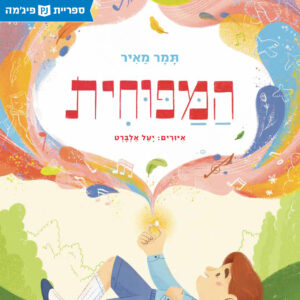 The Harmonica
The Harmonica 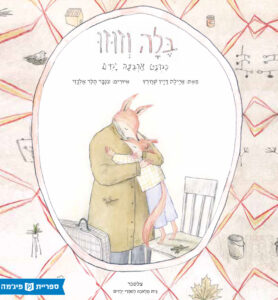 Bella and Zouzou
Bella and Zouzou 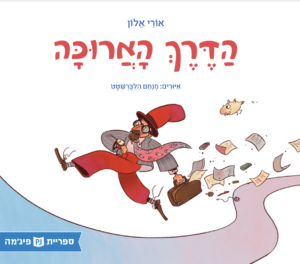 The Long Road
The Long Road 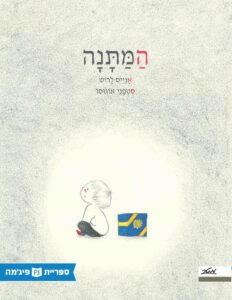 The Gift
The Gift 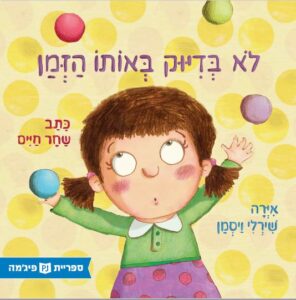 Not at the Exact Same Time
Not at the Exact Same Time 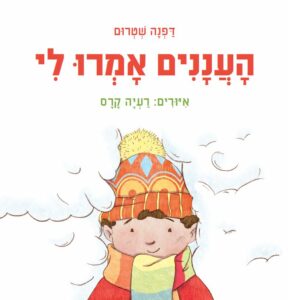 The Clouds Told Me
The Clouds Told Me 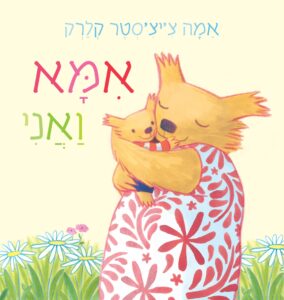 Mummy and Me
Mummy and Me 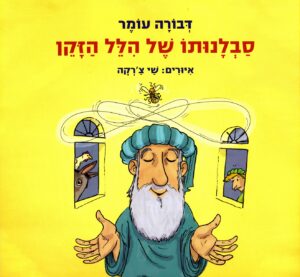 The Patience of Hillel the Elder
The Patience of Hillel the Elder 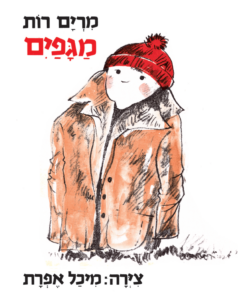 Boots
Boots 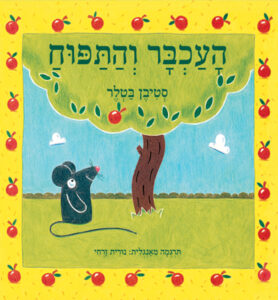 The Mouse and the Apple
The Mouse and the Apple 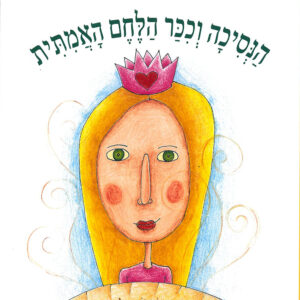 The Princess and the True Loaf of Bread
The Princess and the True Loaf of Bread 

